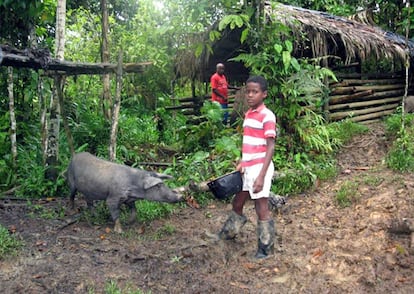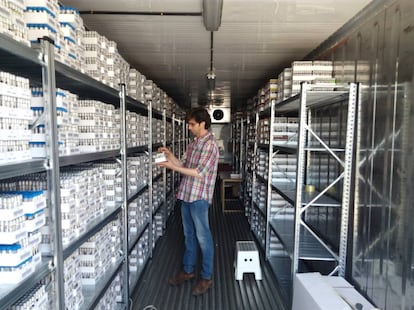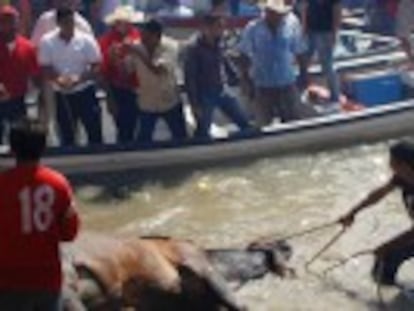Saving the Spanish pigs that went to the Americas with Columbus
Many creole pig breeds, descendants from those that arrived in the New World in 1493, are in danger of extinction – and these scientists are analyzing their DNA to decide which to conserve

Christopher Columbus’s first arrival in the Americas in 1492 was just a drill. Things didn’t get serious until his second trip, which set sail from Cadiz in September 1493. That time, it wasn’t three caravels with a few disoriented sailors, but 17 ships carrying 1,500 colonizers who would change the New World forever. They were coming to stay. And with them, they brought animals that the natives had never seen before: horses, cows, sheep, and pigs. Columbus’s fleet was the closest thing history has seen to Noah’s Ark.
“Beasts, we saw none, nor any creatures on land save parrots and lizards, but a boy told me he saw a large snake. No sheep nor goats were seen, and although our stay here has been short, it being now noon, yet were there any, I could hardly have failed of seeing them,” wrote Columbus in his diary on October 16, 1492. Through his eyes, he had arrived on barren land. To invade it, he would first have to transform it into farmland to feed the colonies. And so he did. “I brought with me horses, mares, mules, and all of the other beasts, as well as seeds of wheat and barley and all the trees and all the choice fruits, everything in great abundance,” wrote Colombus in a letter to King Ferdinand and Queen Isabella during his second voyage.
In 1493, Columbus introduced animals to the Americas that natives had never encountered before: horses, cows, goats, sheep, and pigs.
The father of Bartolome de Las Cases was on one of those 17 ships that crossed the Atlantic in 1493. The expedition made a two-day stop on the Canary Island of La Gomera. “He quickly acquired some heads of cattle, which he and the others there bought, as well as bull calves and goats and sheep. Among other things, some of them bought eight hogs, at 70 maravedís a head. These eight hogs have multiplied to create all the hogs that exist today on the West Indies, now an infinite number,” wrote De las Casas, who died in 1566.
The friar was exaggerating, but he wasn’t entirely wrong. A team of scientists is analyzing the genetic fingerprints of Columbus’s eight hogs, or what was really an army of horses, cows, sheep, goats, and pigs that arrives from the Spain and the Canary Islands after 1493. “The Creole breeds still have strong genetic markers from the Iberian Peninsula,” explains Óscar Cortés, a geneticist from the Veterinary School of Madrid’s Complutense University.
Cortés belongs to the “Red Conbiand,” an association that arose at the University of Córdoba, dedicated to the conservation of the biodiversity of Latin American animals. Its members, from a multitude of investigative centers on both sides of the Atlantic, have created a gigantic genetic database of Spanish, Portuguese, and Creole breeds, including animals like Mexico’s “cerdo pelón,” offshoot of a Spanish pig breed brought to the Americas 500 years ago. This breed has been a main feature of local cuisine for centuries, as a central ingredient of “cochinita pibil” (a slow-roasted pork dish with Mayan roots) as well as popular fiestas, such as the “Cabeza de Cochino” where a roasted pig head is decorated with flags and then two people incorporate it into a traditional dance.

But the “cerdo pelón” on Mexico, like so many of mixed animals breeds, has been pushed to the edge of extinction by the arrival of industrial breeders that can produce more meat in less time. The pelón, a cultural symbol in the Yucatán peninsula, is disappearing despite its natural resistance to disease and its adaptation to the region’s tropical climate; and with it, it’s powerful genes are disappearing as well. The “Red Conbiand,” organized into consortiums according to species (BioPig for pig, BioBovis for cows, etc) is uncovering the genetic links between the different breeds, which is key to protecting them. A team led by Cortés just published a scientific study that establishes the “priorities for the conservation” of the Latin American pigs.
“We see that, from a genetic point of view, there are breeds that must be conserved, in the hypothetical case where we have to prioritize some over others,” says Cortés. The animals flagged for special protection differ depending on the methodology used, as the study shows, published in the scientific magazine Heredity. If breed with foreign roots are preserved in order to maintain greater genetic diversity, you would have to conserve the United States mulefoot, for example, so called for the animals’ hooves which resemble those of mules; or, the Manchado de Jabugo variety, officially in danger of extinction in Spain.
"The Creole breeds have been here for 500 years, adapting to the environment. We could lose centuries of adaptation," warns Cortés
“If the goal is to safeguard the most possible genetic diversity within a breed, you have to conserve pigs like the caracolero from Argentina’s humid region, and the Colombian Pacific criollo cerdo, also close to extinction.
“There is more and more awareness now about the importance of these breeds when it comes to their abilities to adapt to specific environments, frequently with extreme conditions, as well as their roles as genetic reservoirs, or their historic and cultural value,” add the authors of the study, among whom are “Amparo Martínez and Juan Vicente Delgado, from the University of Cordoba. “It’s necessary to implement policies centered on the conservation of genetic diversity, above all in those cases when the viability of a race is being threatened by inbreeding,” they insist.
It seems like an impossible challenge. The white pig industrial breeds – like la Duroc from the US and the Large White from Britain – are displacing native species across the world, or diluting them with cross-breeding. “The Creole breeds have been here for 500 years, adapting to the environment. If they keep being cross-bred, they could end up disappearing. We could lose centuries of adaptation,” Cortés warns. “Right now there are very manufactured breeds, very isolated from the environment. But everything could change – for example, with consequences of climate change, what kind of breed will they produce?”
Sign up for our newsletter
EL PAÍS English Edition has launched a weekly newsletter. Sign up today to receive a selection of our best stories in your inbox every Saturday morning. For full details about how to subscribe, click here.
English version by Allison Light.
Tu suscripción se está usando en otro dispositivo
¿Quieres añadir otro usuario a tu suscripción?
Si continúas leyendo en este dispositivo, no se podrá leer en el otro.
FlechaTu suscripción se está usando en otro dispositivo y solo puedes acceder a EL PAÍS desde un dispositivo a la vez.
Si quieres compartir tu cuenta, cambia tu suscripción a la modalidad Premium, así podrás añadir otro usuario. Cada uno accederá con su propia cuenta de email, lo que os permitirá personalizar vuestra experiencia en EL PAÍS.
¿Tienes una suscripción de empresa? Accede aquí para contratar más cuentas.
En el caso de no saber quién está usando tu cuenta, te recomendamos cambiar tu contraseña aquí.
Si decides continuar compartiendo tu cuenta, este mensaje se mostrará en tu dispositivo y en el de la otra persona que está usando tu cuenta de forma indefinida, afectando a tu experiencia de lectura. Puedes consultar aquí los términos y condiciones de la suscripción digital.
More information
Archived In
Últimas noticias
Alain Aspect, Nobel laureate in physics: ‘Einstein was so smart that he would have had to recognize quantum entanglement’
Imelda Castro, the woman who wants to rule the cartel battleground of Sinaloa
The new victims of the Republican war on Obamacare: Millions hit by soaring health insurance premiums
A country divided on migrant rights: Some US states expand protections while others restrict them
Most viewed
- David King, chemist: ‘There are scientists studying how to cool the planet; nobody should stop these experiments from happening’
- Reinhard Genzel, Nobel laureate in physics: ‘One-minute videos will never give you the truth’
- Oona Chaplin: ‘I told James Cameron that I was living in a treehouse and starting a permaculture project with a friend’
- Sinaloa Cartel war is taking its toll on Los Chapitos
- Mexico completes its trade shift with the entry into force of tariffs on China and countries without trade agreements











































